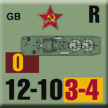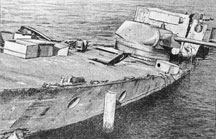| River Gunboats
By Mike Bennighof, Ph.D.
May 2014
During the late 19th century, the Russian
Empire became an economic powerhouse by exporting
huge quantities of grain. The wheat, barley,
rye and maize moved over a network of rivers
and canals to ports on the Black Sea, following
routes pioneered by Swedish Vikings a thousand
years before.
When the Russian Civil War erupted in 1919,
fighting usually followed the networks of
rivers and railroads rather than the primitive
road system. We covered the Soviet use of
armored
trains in an earlier piece. The Civil
War legacy also included reliance on flotillas
of armored river gunboats.
As with the Red Army’s armored trains,
the Red Navy’s river flotillas fell
into disrepair in the late 1920s and early
1930s as older vessels were scrapped and requisitioned
civilian boats returned to their designed
uses. In 1934 the Navy issued a request for
a new river monitor suitable for mass production,
using as many common components as possible
with the tanks of the 1931
program. The new vessels should have two
turrets, armor protection for their vitals
(engine, magazines, fuel) and a very shallow
draft — only 0.5 meters.

BK-241, a type 1125. |
The chief engineer assigned to the task, Yuliy
Benoit, said it was impossible to create a
two-turret armored boat only drawing a half-meter.
But, he believed, a smaller vessel could be
built with only one turret that would meet
the shallow-draft requirement. The Navy approved
his suggestion, and two designs emerged from
Benoit’s bureau. The bigger boat, known
as BKA (bronirovannyie katera, or armored
cutter) 1124, had two turrets initially taken
from T-26 tanks and mounting 45mm guns. The
boat displaced 42 tons, was 25 meters long
and had 12mm of armor on its “citadel”
protecting the engines and other vitals. While
drawing more water than a half-meter, it still
could operate in very shallow waters as it
only drew 0.80 meters.
The smaller version, known as BKA 1125, only
drew 0.5 meters and displaced 29 tons. These
were only slightly shorter (22.6 meters) but
had less armor protection.
When series production began in 1935 at small
shipyards along the Soviet Union’s inland
rivers, the T-26 turret was replaced by the
76.2mm short-barrelled gun and turret used
in the T-28 medium and T-35 heavy tanks. Since
this gun had no anti-aircraft capability,
each boat received two machine guns in anti-aircraft
mounts (12.7mm in the 1124, 7.62mm for the
1125). A slightly modified version of the
1125 was also produced for the NKVD’s
border guard units.
By the time of the Hitlerite invasion, 85
boats had been delivered with 68 more under
construction. They went into action very early,
with boats of the Danube flotilla inflitrating
Romanian defenses to land troops on 24 June
and routing Romanian marines defending the
Danube delta. On the 26th, boats of the Pinsk
flotilla took part in the Soviet 21st Army’s
counter-attacks against the German bridgehead
over the Berezina River.
Though the navy’s river crews fought
very hard, they often could not retreat as
easily as their comrades on land and had to
destroy their boats. Replacements at first
proved hard to come by, despite the large
number of uncompleted hulls in Soviet shipyards
and a design prepared specifically for rapid
construction. Tank turrets could not be diverted
from the new T-34/76
program, and the older turrets were out
of production. During much of 1941, new boats
could only be fitted with alternative weaponry
— usually 76mm anti-aircraft guns taken
from Soviet “blue water” warships
and installed in open mounts.
 Admiral
Nikolai Kuznetsov pressed hard for greater
allocations of turrets and guns from the tank
factories, but at first found little success.
“I can help only in case of overproduction,”
answered Vyacheslav Malyshev, people’s
commissar for tank production. “I am
responsible for the tanks with my head.”
Yet despite threats from Stalin, Malyshev
appears to have consciously rigged production
goals to result in a turret surplus, and soon
the Navy was getting its guns. Malyshev also
diverted powerful American-made Packard engines
to the gunboat program, preferring to use
native-made engines in his tanks. Admiral
Nikolai Kuznetsov pressed hard for greater
allocations of turrets and guns from the tank
factories, but at first found little success.
“I can help only in case of overproduction,”
answered Vyacheslav Malyshev, people’s
commissar for tank production. “I am
responsible for the tanks with my head.”
Yet despite threats from Stalin, Malyshev
appears to have consciously rigged production
goals to result in a turret surplus, and soon
the Navy was getting its guns. Malyshev also
diverted powerful American-made Packard engines
to the gunboat program, preferring to use
native-made engines in his tanks.
As the war progressed, the gunboats gave up
their shallow draft for greater armament,
as official upgrades added more machine guns
and 37mm anti-aircraft guns, and crews unofficially
added more of their own and sometimes 82mm
rocket-launching rails as well. The crews
often installed electric heaters and strengthened
the boat’s prows for ice-breaking, but
neither of these was an official upgrade until
the 1944 model was designed, a version that
did not enter service until after the war’s
end.
The Volga Flotilla made the Red Army’s
greatest victory possible, keeping open supply
lines to the troops fighting for their lives
in the ruins of Stalingrad. Gunboats armed
with 76mm anti-aircraft guns fought off German
Stuka attacks throughout the siege, and those
with tank turrets hove close to the riverbanks
to provide fire support for the troops ashore.
Every night, they ferried reinforcements and
ammunition across the river, and brought back
the wounded to safety.
“About the role of the sailors of
the fleet and their exploits,” wrote
Vasiliy Chiukov, the Soviet commander in Stalingrad,
“I would say briefly that had it not
been for them the 62nd Army might have perished
without ammunition and rations, and could
not have carried out its task.”

Armored gunboat BK-92, sunk by
a “Ferdinand” tank destroyer
near Pinsk, 12 June 1944. |
When the Red Army began its great counter-offensives
to free the Soviet Union of the invaders,
the river gunboats went along. They played
a key role at the battles along the Vistula
and Oder, helping force the way across to
the Kustrin bridgehead in the last battle
for Berlin.
Panzer
Grenadier: Eastern Front includes
a sample gunboat based on the 1124
but standing in for all of them.
Click
here to order Eastern Front!
Mike Bennighof is president of Avalanche Press and holds a doctorate in history from Emory University. A Fulbright Scholar and award-winning journalist, he has published over 100 books, games and articles on historical subjects.
He lives in Birmingham, Alabama with his wife, three children and his dog, Leopold. |
